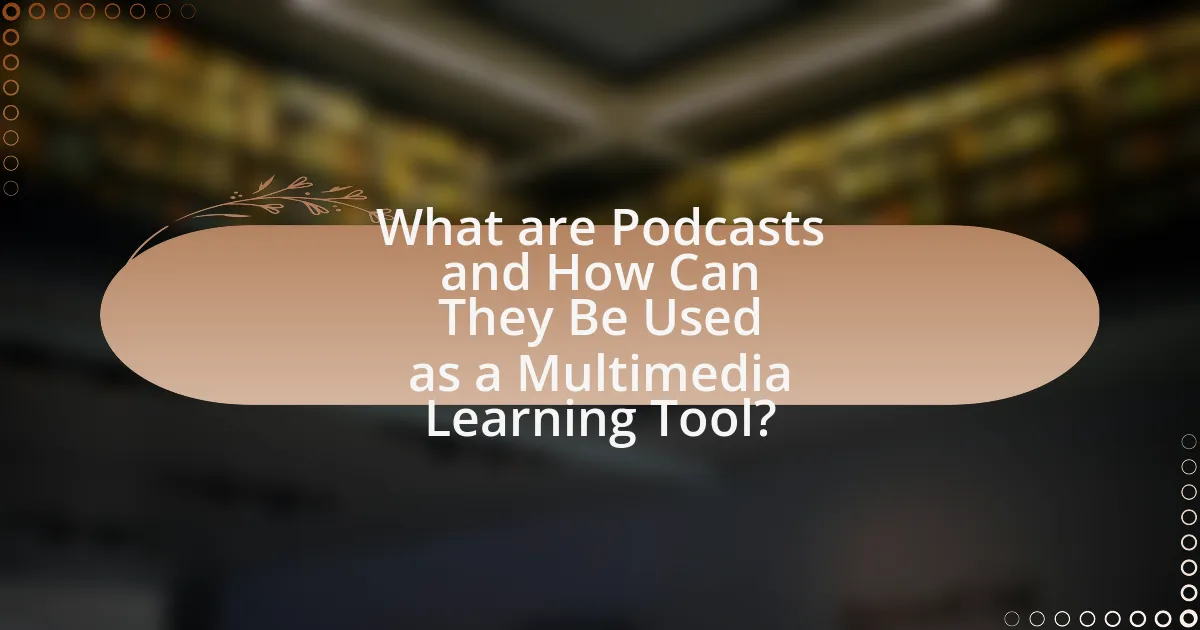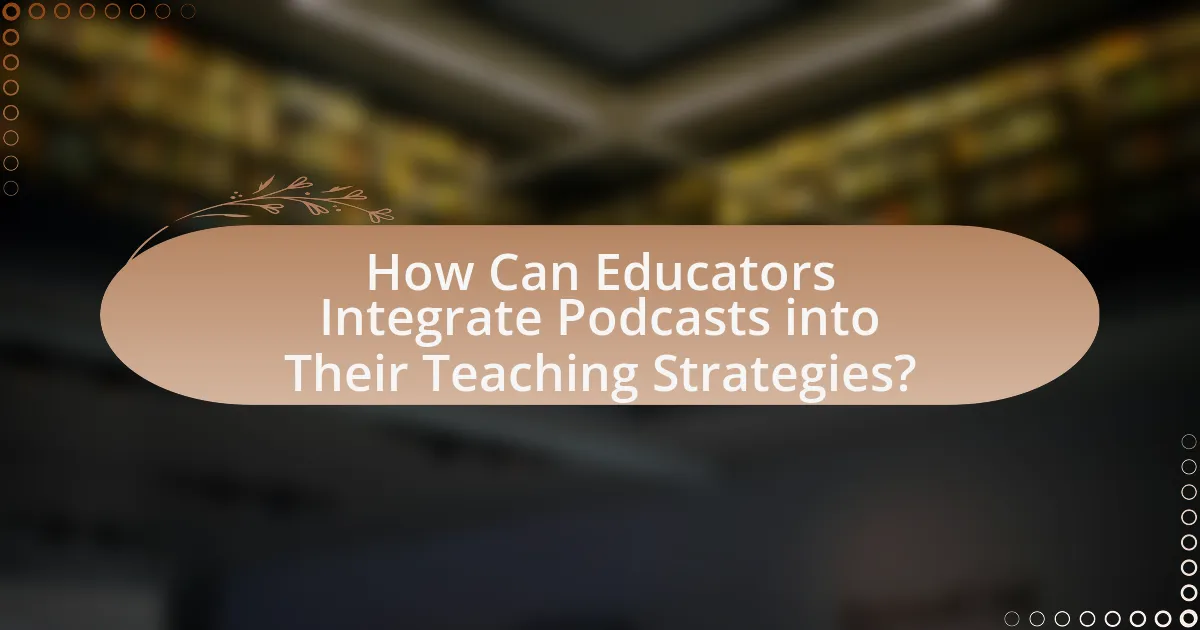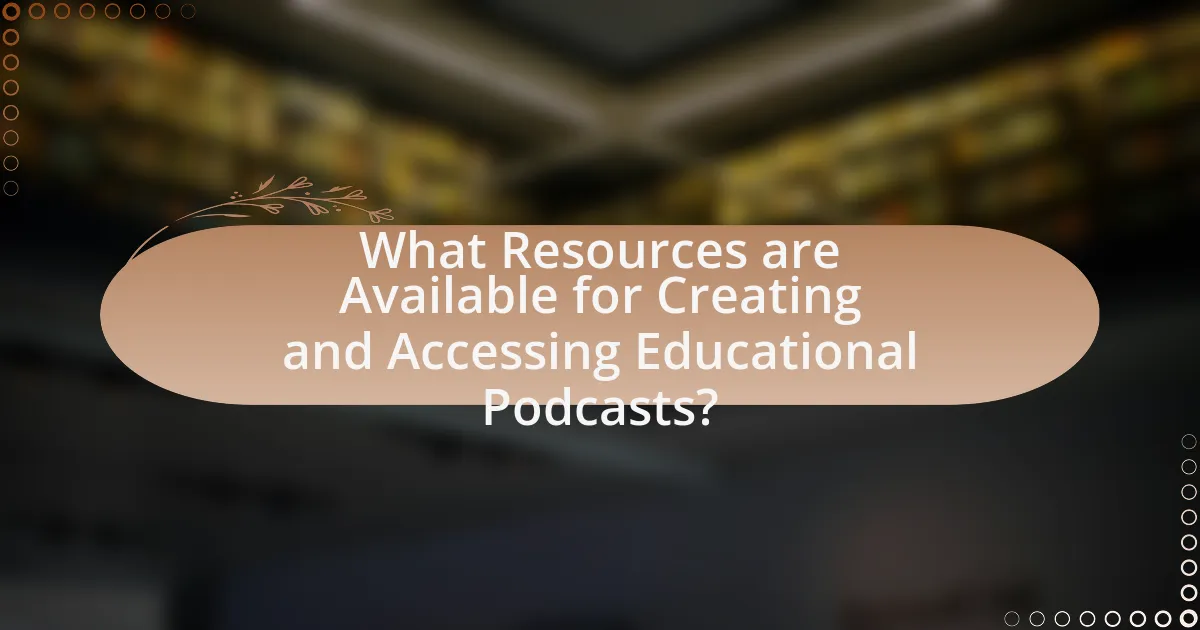Podcasts are digital audio files that serve as an effective multimedia learning tool, offering accessible and engaging content across various topics. This article explores how podcasts enhance auditory learning, improve retention, and cater to diverse learning styles through formats such as interviews, storytelling, and discussions. It also addresses the differences between podcasts and traditional learning methods, the cognitive benefits they provide, and the challenges learners may face. Additionally, the article outlines best practices for educators to integrate podcasts into their teaching strategies, including selecting appropriate content and facilitating discussions to reinforce learning outcomes.

What are Podcasts and How Can They Be Used as a Multimedia Learning Tool?
Podcasts are digital audio files available for streaming or download, typically organized into episodes and covering a wide range of topics. They can be used as a multimedia learning tool by providing accessible, engaging content that enhances auditory learning and allows for flexible consumption. Research indicates that auditory learning can improve retention and understanding, as evidenced by a study published in the Journal of Educational Psychology, which found that students who engaged with audio content performed better in comprehension tests compared to those who relied solely on text-based materials. Additionally, podcasts can incorporate interviews, storytelling, and expert insights, making complex subjects more relatable and easier to grasp.
What defines a podcast in the context of multimedia learning?
A podcast in the context of multimedia learning is defined as an audio program that delivers educational content through episodic series, allowing learners to engage with material in a flexible and accessible format. This definition is supported by the increasing use of podcasts in educational settings, where they serve as a tool for enhancing comprehension and retention of information, as evidenced by studies showing that auditory learning can improve understanding of complex subjects. For instance, research published in the Journal of Educational Technology & Society indicates that students who engage with podcast content demonstrate higher levels of information retention compared to traditional learning methods.
How do podcasts differ from traditional learning methods?
Podcasts differ from traditional learning methods primarily in their delivery format and accessibility. Unlike traditional methods, which often rely on structured classroom settings and physical materials, podcasts provide audio content that can be consumed on-the-go, allowing learners to engage with educational material during various activities, such as commuting or exercising. This flexibility enhances learning opportunities by accommodating diverse schedules and preferences. Additionally, podcasts often feature informal discussions and expert interviews, which can make complex topics more relatable and engaging compared to conventional lectures. Research indicates that audio learning can improve retention and understanding, as it allows for repeated listening and personalized pacing, further distinguishing podcasts from traditional educational approaches.
What types of content are typically found in educational podcasts?
Educational podcasts typically feature interviews, lectures, discussions, and storytelling. Interviews often include experts sharing insights on specific subjects, while lectures provide structured information on topics like science, history, or technology. Discussions may involve multiple speakers debating or exploring various viewpoints, and storytelling can illustrate concepts through narratives or case studies. These formats enhance learning by engaging listeners and providing diverse perspectives, making complex information more accessible.
Why are podcasts an effective tool for learning?
Podcasts are an effective tool for learning because they provide accessible, auditory content that can be consumed on-the-go, catering to diverse learning styles. This format allows learners to absorb information while multitasking, such as during commutes or workouts, which enhances retention and engagement. Research indicates that auditory learning can improve comprehension and recall, as demonstrated in studies showing that students who listen to educational podcasts perform better on assessments compared to those who rely solely on traditional reading materials. Additionally, the conversational nature of podcasts often makes complex subjects more relatable and easier to understand, further supporting their effectiveness as a learning medium.
What cognitive benefits do podcasts provide to learners?
Podcasts provide several cognitive benefits to learners, including enhanced comprehension, improved retention, and increased engagement. Research indicates that auditory learning through podcasts can facilitate better understanding of complex topics, as learners can absorb information at their own pace. A study published in the Journal of Educational Technology & Society found that students who engaged with audio content demonstrated a 20% increase in information retention compared to traditional reading methods. Additionally, the flexibility of podcasts allows learners to integrate education into their daily routines, which can lead to higher motivation and sustained interest in the subject matter.
How do podcasts cater to different learning styles?
Podcasts cater to different learning styles by providing auditory content that appeals to auditory learners, while also incorporating storytelling and discussions that engage visual and kinesthetic learners. Auditory learners benefit from the spoken word, which allows them to absorb information through listening. Visual learners can enhance their understanding by following along with supplementary materials, such as show notes or infographics, that accompany the audio. Kinesthetic learners can engage with the content by participating in discussions or activities prompted by the podcast, allowing them to apply what they have learned in a practical context. Research indicates that multimedia learning, which includes auditory and visual elements, can improve retention and understanding, as demonstrated in studies like Mayer’s Cognitive Theory of Multimedia Learning.
What challenges might arise when using podcasts for learning?
Podcasts can present several challenges for learning, including issues with engagement, comprehension, and accessibility. Learners may struggle to maintain focus during audio-only content, leading to decreased retention of information. Research indicates that multitasking while listening can further diminish understanding, as attention is divided (Hembrooke & , 2003). Additionally, the lack of visual aids in podcasts can hinder the ability to grasp complex concepts, particularly for auditory learners who benefit from supplementary visuals. Accessibility can also be a concern, as not all learners may have equal access to technology or the internet, limiting their ability to utilize podcast resources effectively.
How can learners overcome potential distractions while listening to podcasts?
Learners can overcome potential distractions while listening to podcasts by creating a dedicated listening environment. This involves selecting a quiet space free from interruptions, which enhances focus and retention of information. Research indicates that environmental factors significantly impact concentration; for instance, a study published in the Journal of Educational Psychology found that students who studied in distraction-free environments performed better on retention tests compared to those in noisy settings. Additionally, using headphones can help block external noise, further minimizing distractions and allowing learners to engage more deeply with the podcast content.
What technical issues should users be aware of when accessing podcasts?
Users should be aware of several technical issues when accessing podcasts, including compatibility with devices, internet connectivity, and audio quality. Compatibility issues may arise if the podcast format is not supported by the user’s device or app, as some platforms may only support specific file types like MP3 or AAC. Internet connectivity is crucial, as podcasts require a stable connection for streaming or downloading; interruptions can lead to buffering or incomplete downloads. Additionally, audio quality can vary significantly between podcasts, affecting the listening experience; low-quality recordings may hinder comprehension and engagement. These factors are essential for ensuring a smooth and effective podcast experience.

How Can Educators Integrate Podcasts into Their Teaching Strategies?
Educators can integrate podcasts into their teaching strategies by incorporating them as supplementary learning materials, enhancing student engagement, and facilitating diverse learning styles. For instance, teachers can assign specific podcast episodes related to course content, allowing students to explore topics in depth outside the classroom. Research indicates that 70% of students find podcasts to be an effective learning tool, as they can listen at their own pace and revisit complex concepts. Additionally, educators can encourage students to create their own podcasts, fostering creativity and reinforcing their understanding of the subject matter. This approach not only promotes active learning but also develops essential skills such as communication and critical thinking.
What are the best practices for incorporating podcasts into lesson plans?
The best practices for incorporating podcasts into lesson plans include selecting relevant content, integrating active listening exercises, and facilitating discussions. Educators should choose podcasts that align with learning objectives and engage students’ interests, ensuring the material is age-appropriate and educationally valuable. Active listening exercises, such as note-taking or summarizing key points, enhance comprehension and retention. Following the podcast, facilitating discussions allows students to express their thoughts, ask questions, and connect the content to broader themes, fostering critical thinking. Research indicates that multimedia tools like podcasts can improve student engagement and learning outcomes, as evidenced by a study published in the Journal of Educational Technology & Society, which found that students who used podcasts demonstrated higher levels of understanding and retention compared to traditional methods.
How can educators select appropriate podcasts for their curriculum?
Educators can select appropriate podcasts for their curriculum by aligning podcast content with learning objectives and assessing the credibility of the sources. First, educators should identify specific learning goals and then search for podcasts that cover relevant topics, ensuring that the content is age-appropriate and engaging. Additionally, evaluating the expertise of the podcast hosts and the accuracy of the information presented is crucial; for instance, podcasts featuring experts in the field or backed by reputable institutions tend to provide reliable content. Research indicates that integrating multimedia resources like podcasts can enhance student engagement and retention, making it essential for educators to choose high-quality, relevant audio content that complements their teaching strategies.
What role do discussions play after listening to podcasts in a classroom setting?
Discussions after listening to podcasts in a classroom setting enhance comprehension and critical thinking. Engaging in discussions allows students to articulate their understanding, clarify misconceptions, and explore different perspectives on the podcast content. Research indicates that collaborative dialogue fosters deeper learning, as students are more likely to retain information when they actively engage with it through conversation. For instance, a study published in the Journal of Educational Psychology found that peer discussions significantly improved students’ ability to recall and apply knowledge gained from multimedia resources. Thus, discussions serve as a vital mechanism for reinforcing learning outcomes following podcast listening.
How can podcasts enhance student engagement and participation?
Podcasts can enhance student engagement and participation by providing accessible, flexible, and diverse learning experiences. They allow students to consume content at their own pace and convenience, which can lead to increased retention and understanding of the material. Research indicates that auditory learning can improve comprehension and recall, as evidenced by a study published in the Journal of Educational Psychology, which found that students who engaged with audio content performed better in assessments compared to those who relied solely on traditional reading methods. Additionally, podcasts often incorporate storytelling and real-world applications, making the learning experience more relatable and stimulating for students, thereby fostering a deeper connection to the subject matter.
What interactive elements can be included alongside podcast content?
Interactive elements that can be included alongside podcast content are quizzes, polls, discussion forums, and supplementary multimedia resources. Quizzes and polls engage listeners by allowing them to test their knowledge or express opinions related to the podcast topic, enhancing retention and interaction. Discussion forums provide a platform for listeners to share insights and ask questions, fostering community engagement. Supplementary multimedia resources, such as infographics or videos, can deepen understanding of the podcast content by providing visual context and additional information. These elements collectively enhance the learning experience and promote active participation among listeners.
How can students create their own podcasts as a learning exercise?
Students can create their own podcasts as a learning exercise by following a structured process that includes selecting a topic, researching content, scripting, recording, editing, and publishing. First, students should choose a relevant subject that aligns with their curriculum or interests, ensuring it is engaging and educational. Next, they must gather information from credible sources to support their discussion, which enhances their understanding and critical thinking skills.
After research, students should draft a script or outline to organize their thoughts and ensure a coherent flow of information. Recording can be done using basic audio equipment or software, which is widely accessible. Editing tools, such as Audacity or GarageBand, allow students to refine their audio, adding music or sound effects to enhance the listening experience. Finally, students can publish their podcasts on platforms like SoundCloud or Anchor, making them available to peers and educators for feedback.
This process not only fosters creativity and communication skills but also provides practical experience with technology and media production, which are essential skills in today’s digital world.

What Resources are Available for Creating and Accessing Educational Podcasts?
Various resources are available for creating and accessing educational podcasts, including software, platforms, and educational institutions. For creation, tools like Audacity and GarageBand provide user-friendly interfaces for recording and editing audio. Additionally, platforms such as Anchor and Podbean offer hosting services that simplify the distribution process. For accessing educational podcasts, directories like Apple Podcasts and Spotify feature a wide range of content tailored for learning purposes. Educational institutions often provide curated lists of recommended podcasts, enhancing the accessibility of quality educational material. These resources collectively support the development and consumption of educational podcasts, facilitating multimedia learning experiences.
What platforms are popular for hosting educational podcasts?
Popular platforms for hosting educational podcasts include Spotify, Apple Podcasts, Google Podcasts, and Podbean. These platforms are widely used due to their extensive reach and user-friendly interfaces, making them ideal for educators and learners alike. For instance, Spotify has over 500 million users, providing a vast audience for educational content, while Apple Podcasts is one of the largest podcast directories, offering a significant platform for visibility. Podbean, specifically designed for podcast hosting, offers features like monetization and analytics, which are beneficial for educational creators.
How can educators utilize podcast creation tools effectively?
Educators can utilize podcast creation tools effectively by integrating them into their curriculum to enhance student engagement and facilitate active learning. By assigning students to create podcasts on specific topics, educators encourage research, critical thinking, and creativity, which are essential skills in modern education. Research indicates that students who engage in project-based learning, such as podcast creation, demonstrate improved retention of information and higher levels of motivation (Hattie, 2009, “Visible Learning”). Additionally, educators can use podcasting to provide diverse perspectives and real-world applications of classroom concepts, making learning more relevant and impactful.
What are some recommended podcasts for various subjects and age groups?
Some recommended podcasts for various subjects and age groups include “Stuff You Should Know” for general knowledge, which covers a wide range of topics and is suitable for teens and adults. “Brains On!” is ideal for children, focusing on science and curiosity-driven questions. For history enthusiasts, “Hardcore History” provides in-depth storytelling and analysis, appealing to older teens and adults. “The Daily” offers news and current events, making it suitable for young adults and adults. “Wow in the World” engages younger audiences with fun science topics. These podcasts are recognized for their educational value and engaging content, making them effective multimedia learning tools.
What tips can help maximize the effectiveness of podcasts as a learning tool?
To maximize the effectiveness of podcasts as a learning tool, listeners should actively engage with the content by taking notes and summarizing key points. Active engagement enhances retention and understanding, as studies show that summarizing information can improve memory recall by up to 50%. Additionally, selecting podcasts that align with specific learning objectives ensures that the content is relevant and targeted, which has been shown to increase motivation and focus. Listening in a distraction-free environment further supports concentration, allowing for deeper processing of the material.
How can learners take notes effectively while listening to podcasts?
Learners can take notes effectively while listening to podcasts by employing the Cornell note-taking system, which encourages organized and structured notes. This method involves dividing the page into three sections: cues, notes, and summary. While listening, learners should jot down key points and ideas in the notes section, using abbreviations and symbols for efficiency. After the podcast, they can review their notes, formulate questions in the cues section, and summarize the content at the bottom. Research indicates that structured note-taking enhances retention and comprehension, making it a valuable strategy for podcast learning.
What strategies can be employed to reinforce learning after listening to a podcast?
To reinforce learning after listening to a podcast, individuals can employ strategies such as summarizing key points, discussing the content with peers, and applying the learned concepts in practical scenarios. Summarizing helps consolidate information, as research indicates that summarization enhances retention by forcing the learner to process and articulate the material (Dunlosky et al., 2013). Engaging in discussions allows for the exchange of perspectives, which can deepen understanding and clarify misconceptions. Additionally, applying concepts in real-life situations reinforces learning through experiential practice, as studies show that active engagement with material leads to better retention and understanding (Kolb, 1984).